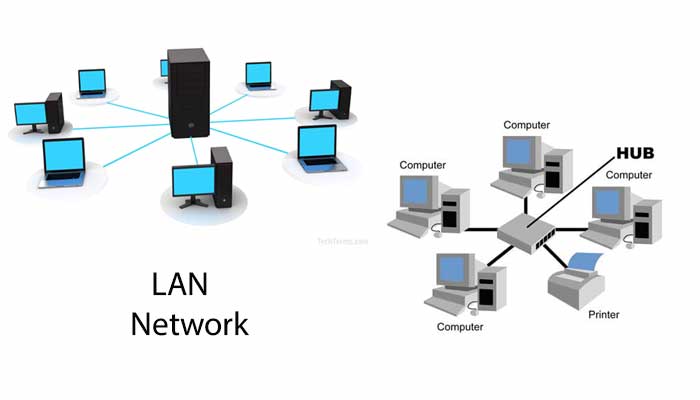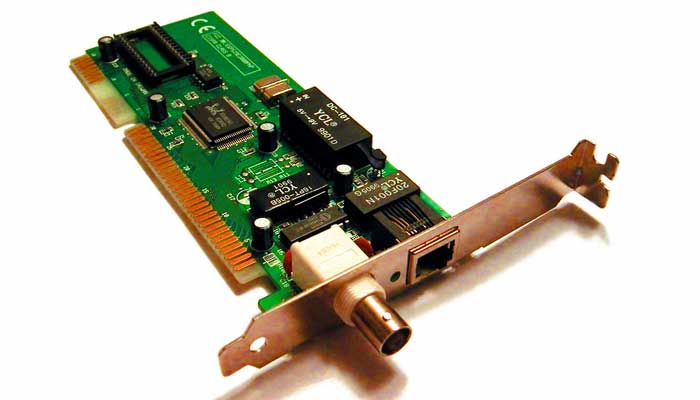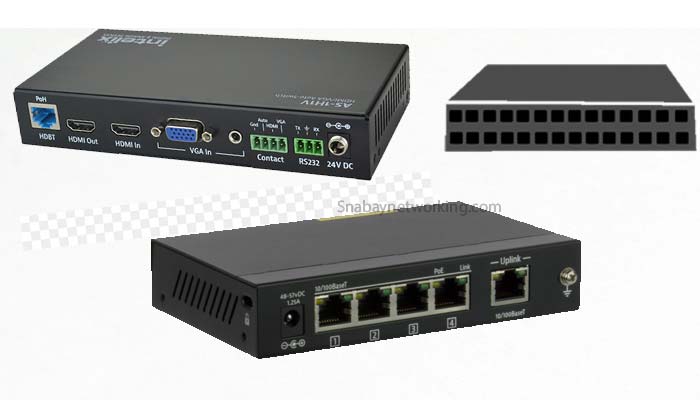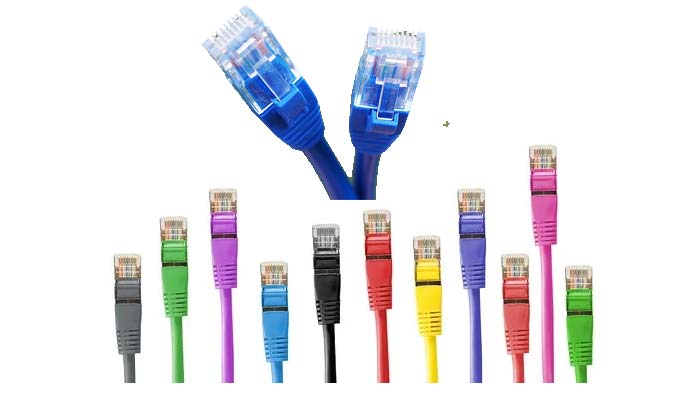Components of Computer Network:- As we know that networking needs some components to work systematically, to make this possible some components come into play to perform a different function and different task according to the requirement of the user and the communication system. To know more about the Components of Computer Network, keep reading this article till the end.
What is Computer Network?
It is simply a set of interconnected computers so as to enable exchange of information between themselves. Generally, these computers could be in the same building or located at various distances. Through the sharing of information, a large number of tasks could be carried out, such as, communication using email, videos, instant messaging; sharing of resources such as devices, printers etc; sharing of software, applications and even computing power; sharing of files. Computer networks also allow users to access and maintain information over the network.  Also, computer networks may be confined to a building, as in the case of LAN (Local Area Network), or they may connect computers over a small geographical region such a city.
Also, computer networks may be confined to a building, as in the case of LAN (Local Area Network), or they may connect computers over a small geographical region such a city.
Components of Computer Network
I have listed some components of computer network and also I have explained about them.
Host
In networking parlance, a host is a computer that is connected to other computers or machines through a connection. The host has its own unique IP address. The host is responsible for storing data so that it can be transmitted to other computers or machines. These end computers are called Remote Terminals.
A host may also have programs, processing power, data or other resources which may be used by Remote Terminals as per their needs. This way a Host serves the needs of many computers at once, thereby increasing the effectiveness and efficiency of the resources involved.
In the case of web hosting, a Host is a web-server. This server stores website files, various programs and applications etc. In this context, a Host refers to the bundle of hardware, software and communication lines required for the hosting service to run smoothly.
Server
In a network, different client computers are connected to the Server. Network operating systems run on the server-side. This gives the server the ability to provide and manage services to different users, groups, security, applications, and similar networking functions. Most operating systems like ibmi as400 and others in the market function this way.
Also, a single system may use and provide resources on a network at the same time. This implies that the machine could act as a server and client at the same time.
Client
On a network, a client is a computer that is connected to and uses the resources of a remote-computer or server. Many networks have client computer nodes connected to a main Server. The server provides resources like files, information, internet and intranet access and processing power. When the processing is done on the local client, then it is called as “client-side”.
Also, a client may be referred to as a program that runs on a local machine which requests some service from the server. A client program is a finite program, which means that a service started by the user is terminated when the service is completed.
Transmission Media
A communication channel which carries the information from a sender to a receiver is called a Transmission Media. Here, the data is transmitted in the form of electromagnetic signals.
A transmission media mainly provides a physical path through which information is carried in the bit form through a LAN. It is therefore, a physical path between a transmitter and receiver in the field of data communication.
The signals can be sent through copper wire, fibre optics, atmosphere, water and vacuum. Basically, transmission media is of two types, wired and wireless. In wired media, medium characteristics are important. In wireless media, signal characteristics are important.
Network Interface Card (NIC)
A hardware component which helps a computer in connecting to a network. It is a circuit board installed inside a computer which provides dedicated network connection to a computer. A NIC is also called a LAN adapter or a network adapter.
A NIC helps in both, wired and wireless communication. NIC allows communication between computers connected via LAN as well as communications over large scale networks through Internet Protocol(IP).
In the OSI Model, NIC acts as both, a Physical Layer and Data-Link Layer device. In this way, it provides the necessary hardware circuitry so that physical layer processes and some data link layer processes could run it.
Hub
In networking, a hub is a networking device which connects various Ethernet devices together enabling them to act as a single network element. The hub contains multiple input/output ports. A signal introduced at the input of any port appears as the output at every port. In simple words, a hub simply broadcasts an input signal to all of its output ports. This way, the bandwidth is distributed amongst the ports, even if a port might be in use or not.
A hub cannot filter data, i.e. all data packets are sent to all connected devices. They don’t have the capability to find the best paths on a network to transmit the data; this leads to inefficiencies and wastage.
Switch
A switch is also like a hub, but it takes in packets being sent by devices that are connected to its physical ports and sends them out again, but only through the ports that lead to the devices the packets are intended to reach. This way, inefficiency and wastage as was noted in the case of hub is avoided in the case of a switch.
A network switch operates at the Layer 2 (the data link layer) of the OSI Model. They also occur at the Layer 3 (the network layer) of the OSI Model where the routing takes place.
There are many ports in a switch. Computers are plugged-in in these ports. Upon arrival of a data-packet to the port of a network switch, the switch examines the destination address, performs required checks on them and sends the frame to corresponding devices. A switch allows unicast, multicast and also broadcast communications.
Router
A router is a networking device which forwards data packets between computer networks. It performs the task of directing traffic on the internet. Any data which is sent over the internet is in the form of data packets. A packet is typically forwarded from one router to another until it reaches its destination node or port.
A router reads the network address information in the packet header to determine the ultimate destination. Then, using the information in the routing table, the packets are directed to the next network on its journey.
A router has two major functions, Forwarding and Routing.
Modem
A modem is an acronym for Modulator-Demodulator. A Modem converts digital data to a signal so that it could be easily sent and received over a phone line, cable, or a satellite connection. The signal carried over the phone line or such other medium is transmitted in analog form.
A Modulator converts information from digital to analog mode at the transmitting end. While a Demodulator converts the same from analog to digital at the receiving end. Thus, in real-time, a modem converts data between analog and digital formats to enable a two-way network communication. These modems may occasionally develop a problem for which you will need professional assistance to resolve the issue at hand.
Firms like Micro Center (click for more information), for example, may be able to assist you in this area.
Nowadays, in the era of high speed digital modems, the signals are much simpler and don’t require analog-to-digital conversions.
Repeater
In any network, a signal is attenuated due to the transmission media or the limitations of transmitting technology. This poses a limit on the coverage area of a LAN or cellular networks. To solve this problem of attenuation, repeaters are installed at certain intervals.
Repeaters simply amplify or regenerate an input signal and then retransmits it. They are networking devices which operate at physical layer of the OSI Model. They help to expand the network coverage area and work as Signal Boosters.
Bridge
In a network, different LANs can be connected to form a larger LAN. This form of aggregating networks is called as network bridging. The bridge connects different LANs so that they appear as a part of single network. Thus, a bridge connects two or more different LANs which have similar protocol and provides communication between the devices between them.
A network bridge acts to divide a network into such logical segments that the collision between the data packets being sent over the network is reduced. This leads to improvement in performance of a network.
Gateways
In a network, a Gateway is a translator between two systems that use different communication protocols, data formats or architectures. Thus, they serve a transitional task. They help in the conversion of one type of protocol into another. A gateway could be used for both, LAN and WAN (wide Area network) interconnections.
A Gateway can be defined as a node which acts as an entrance for other nodes in the network. It is also responsible for enabling traffic flow within the network. It uses more than one protocol for communication, therefore, its activities are much more complex than a switch or a router.
Network Operating Systems
In a network, different client computers are connected to the Server. Network operating systems run on the server side. This gives the server the ability to provide and manage services to different users, groups, security, applications and similar networking functions.
The basic purpose of NOS is to enable file sharing, hardware access such as printer access among multiple computers in a network, usually in a LAN.
Some examples of NOS are UNIX, Linux, Mac OS X, Microsoft Windows Server 2008 etc. All operating systems have a set of commands that work intricately together to perform functions such as turning on your system, running simultaneous programs etc. You can opt to know more about the various commands and functions on different articles like the ones provided by Linode.
There are certain advantages of NOS on a server such as stability, better security management, easy and integrated upgrade of new hardware and technology in the system etc.
CPU
The CPU (Central processing unit) functions to process data. It is the place where data processing such as calculating, sorting, searching etc takes place according to some set of stored instructions. Whatever work we do on our computers, CPU makes the processing of data possible.
The CPU has Three components. They are: Control Unit (CU), Immediate access store (IAS), and ALU (Arithmetic and Logic Unit).
The CU controls the flow of data within the system. The IAS holds all the data and programs currently being used by the CPU. The ALU performs all arithmetical and logical operations such as calculations, comparison, logical evaluation etc. Every task carried out by the computer is performed here.
Memory
A Memory is a place where data and instructions are stored inside a computer. The data to be processed or already processes, instructions required for processing data are all stored in the memory.
A computer memory is of three types:
Main memory is the place where only currently worked data and instructions used by the computer are stored. It is volatile.
Cache memory is the highspeed semiconductor memory which acts as a buffer between CPU and the main memory. It provides short term storage.
Secondary memory is slower than main memory. They are used for permanent data storage. The CPU uses the contents of secondary memory through main memory and input-output routines.
RAID Card
RAID (Redundant Array of Independent Disks) is a hardware or software, and virtualises physical storage drives to improve performance and create data redundancy.
A RAID card manages a computer’s hard disk drives or solid-state drives (SSDs). This enables the disk devices to work together to improve their performance and reduce redundancy. A RAID can be hardware or software.
Hard Disk
As seen above, in the memory part(SN17), Hard disk are the secondary memory for a computer. The data and information stored on a Hard disk are not lost even after power is turned off.
The CPU doesn’t directly access the information stored on the Hard Disk. It does it through various input-output routines, which loads it in the main memory.
At the Hard disk are physically located the information contained in our files and folders. A Hard Disk can now store hundreds of GB. It is a stack of disks placed inside a solid/protective encasement where the data is magnetically stored. The disks can spin extremely fast in order to enable data access anywhere from the Hard Drive.
RAM
RAM is the main or primary memory of a Computer. It is a hardware device on which is temporarily stored the current instructions and data being used by the CPU.
Here, the data is randomly accessed and retrieved unlike the case of Hard disk, Compact disks etc which makes access time faster. Access time in RAM is independent of the address,
RAM is a volatile memory. This means that it needs power supply to maintain and keep the data accessible. Once, the power is turned off, all the data stored in RAM is lost.
RAM is small, both in terms of physical size and amount of data it can store.
ROM
ROM (Read only memory), is a memory storage medium which stores information permanently. We can only read programs and data stored on the ROM but cannot modify it or modify it with extreme difficulty. Thus, ROMs are non-volatile, which means its content is intact even if there is no power as opposed to RAMs.
ROMs store firmware, which is a permanent software stored in integrated circuits. A manufacturer creates a specifically designed ROM chip into a device during the building process.
Conventionally used ROMs are pre-programmed to suit its intended hardware. It often controls functions that are both integral to the utility of the device and unlikely to need modification or personalization. One kind of data usually stored in a ROM chip is the Basic Input-Output System (BIOS).
Hostname
In networking, a hostname (or computer name) is what a certain device is called on the network. This helps in distinguishing devices within the LAN. Also, with the help of hostnames, computers could be found by others in the network, thereby enabling data exchange within a network. Hostnames are used on the internet, but as a part of the fully qualified .
For example, if Computer Alpha had two computers on its network named “bravo” and “charlie,” the domain name “bravo.computeralpha.com” is connecting to the “bravo” computer.
Hostnames give specific names which refer to a host, making it usable for the devices connected to a network and to the people. They describe physical addresses and network nodes, which have multiple domains under a single host.
If a computer is available on the internet as well as locally, then computers can be uniquely assigned a combination of Hostname and Domain.
IP Address
IP (internet Protocol) address is the address of our computer on a network. It is associated with a specific device or computer network. It helps in connecting our computer to other devices on our network and all over the world through the internet.
An IP address is made up of numbers or characters. For example, 501.20.34.231
All devices connected to the internet have a unique IP address. There are billions of IP addresses over the internet.
There are two IP versions, IPv4 and IPv6 (newer and more spacious version). IPv6 fulfils the address needs of all internet users and devices. However, your IP address can be traced, so if you’re looking to protect your privacy, you might want to learn how to easily avoid being blocked whilst web scraping via proxies!
DNS Server
A server is a computer which hosts some service(s) which can be accessed over a network or the internet. For instance, mail servers, which hosts and manage email services.
Similarly, a DNS server manages DNS Services.
Domain Name Service (DNS) is just like a phone book. Each device connected to internet has a unique IP address (in the form of digits or hexadecimals, so as to enable other devices to find a specific device on the internet). It is not easy or inconvenient for humans to remember IP addresses. So, humans access websites on the internet through the DNS. DNS servers translates domain names to IP addresses so that browsers may be able to load internet resources.
MAC Address
MAC (Media Access Control) address is a hardware identification number (48-bit serial number) that uniquely identifies each device on a network. It is manufactured onto every network card, such as the NIC or Wi-fi card. It cannot be changed.
Since there are millions of network devices, unique MAC addresses are provided by using six two-digit hexadecimal numbers which are separated by colons. For instance, 01:0e:76:c2:b0:7a.
A user need not know the MAC address but it is automatically recognised by most networks.
Media Access Control Address is a physical address which works at Data Link Layer of the OSI Model.
Port
In networking, a port is a programmatic docking point through which information flows from a program to the computer over the internet.
In common usage, a port is a physical docking point through which an external device could be connected to a computer or other devices.
In the parlance of Internet protocol suite, such as TCP (Transmission Control Protocol), a network port is a number which serves as a endpoint communication between two computers.
Network Protocols
In a network, different devices are connected. To enable transmission of data and communication between the devices in the same network, an established set of rules is required. These established set of rules are called as network protocols.
Network protocols allows the devices connected in a network with each other regardless of the differences (such as internal processes, design or structure) between them.
It is due to Network protocols, one is easily able to communicate with other people and devices all over the world.
In order to exchange information with the help of Network protocols, an understanding of how a network is logically organised or designed is needed. One of the most popular models used to establish communication between two systems is the OSI (Open Systems Interface) Model.
The different types of Network Protocols are: TCP (Transmission Control Protocol), IP (Internet Protocol), PPP (Point-to-point protocol) etc.
Network Cables
Network cables work as physical transmission medium between different computers and components in any network. They enable communication, connection, transfer of data and information between computers.
There are various types of communication cables. The suitable type of cable to use depends on the structure, topology, cost considerations and overall architecture of the system.
The most common Network cables are “twisted pair cable” widely used in LANs. Other types of network cables are Fibre optic, coaxial cable, multipair cables etc. These cables vary in their bandwidth, resistance to signal interference, attenuation properties etc.
Second Explanation of the Components of computer network
Components of Computer Network
- Sender Computer: The sender computer is also known by the source which creates the message to be transmitted to the receiver’s computer.
- Communication Equipment at sender’s end (Modem): It converts the sender’s message which is in digital into an analog signal to avoid the noise and distortion and increase the speed of transmission and when an analog signal comes from receiver’s end it converts back into a digital signal to understand the computer.
- The communication channel (telephone cables): It is the medium in which the messages are carried out, it can be wired or wireless.
- Communication Equipment at Receiver’s End (Modem): It converts the analog signal which comes from the sender’s end into a digital signal.
- Receiver Computer: It is the receiver computer when the sender sends a message, it decodes that message put that on screen for the receiver person.
Hardware components of computer network
There are some hardware components of networking that helps in building a network to make communication possible. Some of these are as follows:
Client: a client is a computer that uses and accesses the network and shared resources. Basically, the client sends the request to the server and the server performs according to the user request.
Server: It is the computer that stores all the data information in one place and when the client request any data or information which is stored in then the server serves according to the client request.
NIC: It stands for Network Interface Card (NIC) that holds the physical address of the computer. It also prepares and sends, receives and controls the data in the network. It passes and receives the data through the physical layer.
NOS: The NOS stands for Network Operating System is a program that runs on computers and servers and allows the computers to communicate with each other over the network.
Switch: Switch is a networking device that performs the task like data flow and control and error detection. It is an advanced version of Hub and it is a layer two device that operates at the Data link layer of the OSI model. It’s every port carry a separate collision domain.
Hub: It is a networking device that operates at the physical layer of the OSI model and its every port carries multiple collision domains. It covers the frame in bit/ byte or in the electrical signal.
Router: Router is a device that allows connecting multiple computers of the different networks simultaneously and they able to share the data, information, and resources to each other.
Gateway: It allows us to connect two different networks.
Cables: It is the medium through which data and information are carried from one device to another device. The wires which are used as a medium are coaxial cable, shielded twisted pair cable, unshielded twisted pair cable, and fiber optics cable.
Download Components of Computer Network PDF
To download Components of Computer Network PDF- Click here.






Leave a comment